freete reviews
I bought a pair of Freet Connect for my partner, Adrian as they looked so comfortable on a friend in Orkney. Adrian was an enthusiastic runner and climber before a traumatic brain injury in 2016 left him with hemiplegia: left-sided weakness and neglect.
Freete reviews
Tom Langhorn, the Scottish Bushcraft expert, explains why we should go barefoot in his video – Barefoot and Minimalist Footwear Benefits? Past to Present Comparison
Hi guys
Just dropping you a line regarding the outstanding service your company has yet again provided.
Thanks so much for your speed of proccesing returns and also the quality of the shoes you make, I now have 3 pairs and they are my go to gym shoe right now. I work as a strength and conditioning coach so I’m in them all day every day and I couldn’t be happier with there performance.
I get loads of questions about them in the gym and people are starting to really come around to the idea of barefoot shoes as an important part of their kit for training
I am 38 and started running with Freet 2 years ago. I could never run before, with regular shoes, because my right knee would always hurt after 15 min. My husband runs the marathon (2h48), + cross country and some trail, and is friends with a physiotherapist who specializes in runners and minimalism. This friend suggested I tried minimalism and sent me a training program from “La Clinique du coureur” (Canada). I bought my first Freet shoes, and started from scratch. Of course it was frustrating to follow the (very slow) program, so I took some liberty… and injured my foot, and then my calf, a couple times and learned my lesson. The training needs to be very progressive. I can now run 45 min to an hour / 7-9 kms with Freet, no pain ! My knee was fine all along. Our 2 boys (11 and 9) wear minimalist shoes all year long. My husband is (very slowly) transitioning to minimalism, his shoes are zero drop, I’m hoping he’ll join my Freet adventure soon ! But I guess the transition is trickier for someone who runs as much as he does.
Anyways, minimalist shoes makes so much sense ! I could never have started running otherwise. And hiking is totally different too. AND the impact on overall posture is amazing. I could go on and on… THANK YOU !!
From Dr Nicole Shaer, GP, 44, Orkney/ Cape Town:
I bought a pair of Freet Connect for my partner, Adrian as they looked so comfortable on a friend in Orkney. Adrian was an enthusiastic runner and climber before a traumatic brain injury in 2016 left him with hemiplegia: left-sided weakness and neglect.
What an incredible suprise it was to discover that the increased stimulation of his left sole, felt through the barefoot shoe, counters the reduced bodily awareness of his condition! In the Freet Connects, Adrian walks more evenly, with better ankle control, to the extent that in Freets he can go without the long-term ankle brace required when wearing standard / cushioned shoes.
Though just a study of one, Adrian’s case suggests potential, clinically significant benefit of barefoot shoes for people who have reduced awareness or sensation in the feet. I wonder what we might all gain by reawakening our bodies to the ground that holds us?
Please see Mel’s review on Mudee:
Wearing Freet Respond for a 3,100 mile foot race:
I wanted to write in a bit more detail about my experiences wearing Freet footwear at the world’s longest certified footrace – the 3100 mile race – 5649 laps around a city block in Queens, New York.
This was my second attempt at the race having successfully completed the full distance, well within the 52 day cut-off, in 2014.
My history with barefoot shoes is that I have long experience of finding it difficult to find shoes that fit properly. I have very wide feet and they seem to have got wider with more and longer ultras. As a result of this I decided, in early 2014, to turn to foot-shaped shoes as by then I believed that this course of action might be more fruitful and so it proved to be.
Since early 2014 I have been wearing barefoot shoes for everyday life and since June 2016 I have been wearing them for all my running and racing too. This is quite a change considering I had transitioned from the mega-cushioned Hoka shoes. Indeed, my 2014, 3100 race was run in Hoka footwear!
Clearly the Sri Chinmoy Self-Transcendence 3,100 mile race, now in its 22nd year, is a phenomenal test by any standards and to run it in minimalistic shoes isn’t a decision I took lightly.
In addition the organisers, the Sri Chinmoy Marathon Team, always stress the toughness of the course, quoting that it is all concrete pavements, no asphalt or‘ black-top’ as they call it. It should also be noted that parts of the busy 0.5 mile lap in downtown Queens, are uneven, tilting and requiring keen observation especially at night, to avoid tripping.
I wasn’t trying to prove anything and always had a bag full of various insoles, cushioning footbeds and so on to give me the greatest number of options when choosing exactly how much additional cushioning I needed at any one time.
I also had shoes in both my usual size and also one size larger to allow for additional inserts as required. If it had come to it I would have switched to a zero-drop, cushioned shoe – something like the Altra shoes came to mind – but this was never needed.
The race comprises an invited field of usually 10-14 athletes, the majority of whom are disciples of the late Indian guru, Sri Chinmoy who settled in Queens in 1963 and went on to found the Sri Chinmoy Marathon Team who now organise races in over 40 countries around the world, ranging in length from 2 miles to 3100 miles!
Runners are expected to be on the start line every morning at 0600 hours and must finish at midnight. Athletes can leave early if they want but obviously that means that they have less time in which to log the required average of 60 miles a day to achieve the full distance within the 52 day cut-off.
An army of volunteers from the Sri Chinmoy organisation keep the race going, 18 hours a day for 52 days. A team of cooks keep the runners fed and watered, another small team keep the camper vans secure overnight and get everything ready for the 6am start everyday. Every runner is accommodated in a simple apartment nearby and volunteer drivers chauffeur the runners home every night.
Every lap is timed and recorded manually and because the course has been officially measured and certificated by US Track and Field, records for multiple, ultra long distances can be claimed and authenticated there.
I have been pursuing my project Journey to 750 records for some years now and my initial interest in the 3100 was sparked by the opportunity it presented to set records beyond the 1000 mile point, which up to 2010, was the longest distance i had ever covered.
I started the race using a 2mm flat footbed under a pair of insoles in both the Freet Respond and Freet Connect shoes. To accommodate these I used a size larger than normal for me. My typical routine was to run/walk for approximately 4 hour periods after which I would rest in the roadside camper van allocated to me for about 20 minutes. Usually using the time to eat and sleep before staggering back out onto the busy pavement to resume the task of covering at least 109 laps before mid-night.
I was keen to use both the Respond and Connect shoes as I believe in a bit of variety in this type of race, feeling that it is beneficial both physically and mentally. For no particular reason I tended to use the Respond until about tea time and then switch to the Connect until the end of the day.
The summers in New York are notorious for the their heat and humidity. In fact, if they can arrange it, New Yorkers try to be elsewhere over the summer period! This year the heat and humidity were of record proportions with multiple days on which the mercury passed 35deg C and the morning and evening humidity levels made walking, let alone running, a severe trial.
On the whole I run well in the heat. I arrived at the race very well heat acclimatised – thanks to my DIY heat chamber in Orkney – however this year’s conditions, especially during the afternoons, were beyond my ability to adapt – especially with regard to the fierceness of the sun which slowed me to a walk during the day and then when I was able to start running again in the evening I simply couldn’t catchup with the required daily mileages and gradually slipped behind my schedule.
I found the breathable uppers on the Respond shoes excellent in those conditions, keeping my feet as cool as possible given the excessive heat.
It became apparent in the early stages of the race that I was experiencing fewer foot issues than other runners. One walker had to abandon the race after about 14 days with her feet looking like raw meat!
Through long experience I have come to understand that having ‘foot-shaped’ shoes is a pre-requisite to achieving foot comfort and performance when walking and running.
I only got my first, superficial blister after over 2200 miles of running! This obviously says a lot about the success of my footwear strategy.
As my race progressed I became aware, after about two thirds of the race duration, that I no longer needed the 2mm footbeds in my shoes ie I needed less cushioning as the race progressed!
By midnight on August 8th – 52 days into the race – my time had run out and I had to stop. I had covered 2,904 miles a little shy of the targeted 3,100.
I had gone through 5 pairs of Freet shoes. As I had used a mix of running and walking the main area of wear was on the heels, with one heel wearing down first. Other parts of the shoe showed little wear.
Yes, my feet were tired and aching at the finish but I sustained no injuries at all and had a tiny handful of small blisters – none of which had to be treated in any way – as my souvenirs of the race.
William Sichel, Orkney
Would I be disappointed? – after all, this is THE product I’d been waiting to be released.
As a reasonably recent convertee to the barefoot way of life I had been loathed to give up my sturdy, supportive,weatherproof walking boots- they are after all what most people rely on for longer walks.
Test week 1 – South West Coast Path in balmy sunshine.
Verdict. The barefoot experience I was used to but from a fantastic looking brown boot- even with shorts! Superbly comfortable, ‘snuggling’ to the ankle, giving support and holding the foot back on those downhills yet still allowing the freedom of movement. Incredibly grippy on all those hills, even the loose gravely surfaces. 7 days walking- 15 ish miles per day, no wearing in and my mudees were the most comfortable boot I’ve ever had.
Test week 2 – Rain, rain, rain ‘Up North’.
Verdict. Grip brilliant- I just love the way your feet relax and mould to the terrain giving you confidence and surefootedness ( is that even a word ?) like no other. BUT.. will they be weatherproof? I hadn’t cleaned or treated them in any way since taking them out of the box. Despite paddling through various streams, wet grass and muddy puddles my feet were always dry at the end of the day- pretty good for a boot that is described as ‘weatherproof’. Hubby was wearing boots from another ( more expensive) company and sadly had wet feet.
All in all a fairly perfect barefoot boot, and good looking enough to wear around town too- well worth waiting for. Just about to order two pairs in black – one for me and one to keep hubby’s feet dry.
Belinda S, Skipton
Mel wrote a review of Urban on her blog, BareSteps:
From Nicholas M:
‘I am a new convert to Freet – having bought my first pair (Urban) a week or so ago – and they were 47 and perfect size for me.
I am wondering how I have managed until now. I am almost 81 and have never felt comfortable in shoes until now! Thank you so much.’
At just 6.5mm including in sole they are quite minimal. There is very little between you and the ground meaning you feel a lot of what is underneath you. The MulitiGrip outsole provides very good protection from the sharper objects below you. The mix of ground feel and protection from the Tanga is perfect. They can be worn for long periods over harsh surfaces with little issue or discomfort.
Freet Footwear Tanga – Review
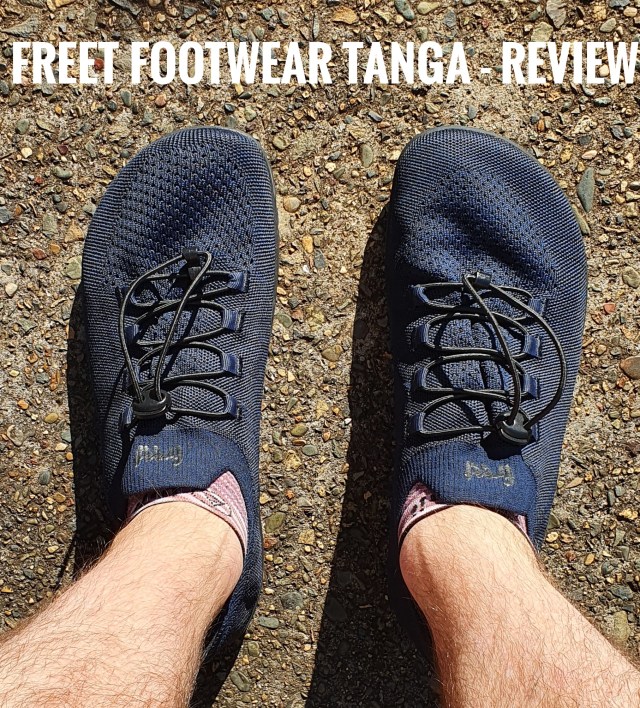
Freet Footwear are a UK company manufacturing a range of vegan friendly barefoot or minimal footwear. There footwear is designed for two categories being sports or everyday. I chose the Freet Tanga as a casual, everyday shoe ideal for multiple occasions. These shoes are equally suited to a days hiking in the bush to a casual restaurant setting worn with a pair of jeans.
In Australia Freet Footwear is available through online retailer Bprimal. Bprimal specialise is minimal and functional footwear, shipping throughout Australia and New Zealand.
Over the past 4-6 weeks I’ve given the Freet Tanga a good test in multiple settings and been very impressed. My very first impression when wearing the Tanga was how generously wide they are. Even for an exclusive wearer of barefoot shoes, the Tanga feels wide. The other first impression was just how comfortable they are. The Tanga is amazingly comfortable, in fact possibly the most comfortable shoe I’ve worn. Big claims on first impression.
The Tanga is certainly a minimal shoe. With a stack height of just 6.5mm which can be reduced to 4 mm by eliminating the insole. It features a ‘CoffeeFlyMesh’ upper with the upper made from 100% recycled coffee grounds. The upper is durable, breathable and very comfortable when wearing with or without socks. It has an elasticated lacing system as shown in the picture below, however comes with traditional laces in the box which is a nice touch from Freet. It also features a MultiGrip performance outsole for grip on light trails and pavement. At just 410 grams they are on the light side which only adds to their comfort.
After a week or so of wearing the Tanga in everyday settings I really wanted to test them in the wild. I was certainly impressed when i took them on a 3 hour family hike. This hike was mostly over loose packed dirt single trail with both steep down and uphill sections and the Freet tanga was most definitely up to the task. They were responsive and stable yet they had impressive grip on the trail. This hike again highlighted the comfort levels of the Tanga and after three hours walking my feet felt brand new.
Even by barefoot footwear standards the Tanga feels wide. However they don’t look overly wide on the foot. What this means is the feet are given more than ample room to splay every step you take. This only adds to the comfort the Tanga provides. The other reason for the comfort is the light material of the CoffeeFly Mesh upper. This material is light and breathable meaning your feet stay cool over long periods in the shoe.
At just 6.5mm including in sole they are quite minimal. There is very little between you and the ground meaning you feel a lot of what is underneath you. The MulitiGrip outsole provides very good protection from the sharper objects below you. The mix of ground feel and protection from the Tanga is perfect. They can be worn for long periods over harsh surfaces with little issue or discomfort.
One of the greatest things you can do in the early stages of your barefoot journey is spend a lot of time barefoot. This will strengthen your feet and help absorb the different impact that changing from a life of cushioned shoes has had on your body. For someone in the early stages of their barefoot transition wearing the Tanga in everyday situations is a great way to strengthen and splay your feet. Obviously we can’t be barefoot all the time, although Covid-19 and working from home for many has changed this to some degree. For most situations the Tanga will be a suitable footwear.
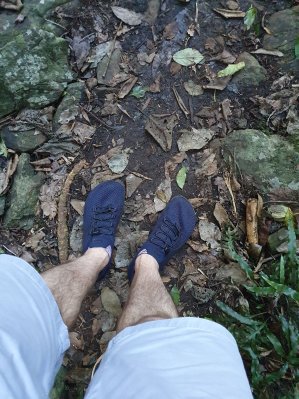
For those further down the path in their barefoot journey the Tanga could just become your everyday go to shoe. It’s a shoe you could wear in most situations and be on your feet for long periods with little to no discomfort. Over the course of my time in the Tanga I’ve used them for many hours at a time with my feet always feeling fresh afterwards.
The Tanga has all the attributes of great minimal footwear. As previously discussed they are wide in the forefoot toe box. They are flexible and allow the foot to move naturally, this is further enhanced by the wide toe box. They are also flat and thin yet provide enough the protection required.
Most barefoot runners put a lot of thought and intention into the footwear we run in. Just as important and possibly more difficult to find is the footwear we live in. Finding suitable barefoot/ minimal footwear for everyday casual , work and formal situations is difficult. Minimal footwear is usually more expensive then the traditional alternative making them a more considered purchase. At AUD $159 the Freet Tanga is more than good value for money it is priced at a similarly to typical shoes in the non minimal category. This makes them a great option for those committed to spending their time in better shoes through to even the casual observer of minimal footwear.
I’ll go out of this review by repeating what I said at the start. After wearing extensively for 4-6 weeks The Freet Footwear Tanga is the most comfortable shoe I’ve ever worn! I put that statement in bold because it deserves to be. These shoes are a delight to wear. Whether this be in everyday situations in our concrete world. Out in the trails hiking, spending time at parks or beach. Or equally fashionable dressed in jeans for a meal at a restaurant. The Tanga is a great shoe that I will be wearing for many years to come.
Disclaimer: For the purpose of this review I was provided with a discount through bprimal.com.au.
BPrimal based in Brisbane sell a range of minimal and functional footwear through Australia and New Zealand online. they have Australia wide shipping for AUD $9.95 on entire range.
The uppers are a thin, light and airy material, allowing your feet to keep cool. This does mean that they soak through quickly, but they don’t gain a lot of weight when wet, and they also dry very quickly.
Freet Connect 2
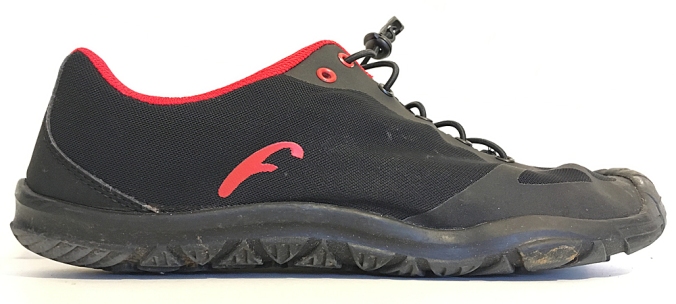
It’s been a few years since I last reviewed a pair of Freet shoes. The company has been busy developing its brand and has extended its impressive range of minimalist and barefoot footwear, not least to include kids. I was very pleased to be offered a pair of the new Connect 2 shoes, not just for me, but also for my young son. Review of the kids’ version here.
As the name suggests, the Connect 2 is an upgrade from the Connect shoe. I haven’t had a pair of the original Connects, so I can’t compare the upgrade, but I am mightily impressed with the Connect 2. If there’s any question about first impressions, I had these delivered to my work address and within a few minutes of me opening the box, one of my colleagues went on to the Freet website and bought himself a pair.
They are a ‘normal’ shoe, in as much as all the toes are together rather than Freet’s distinctive 4+1 design. The chassis is nice and wide around the toes, allowing free movement and toe-spread, while the uppers are supple and soft, allowing them to fit snugly without feeling tight and restrictive. They are sized a little small, so on the advice of Freet I went for an EU-size larger than usual.
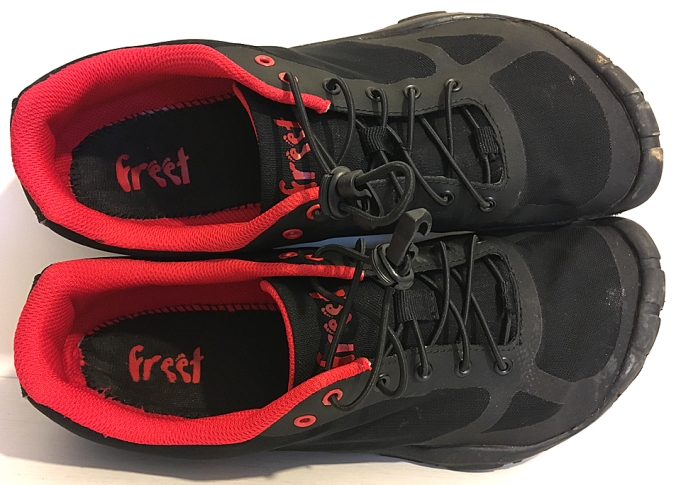
The sole is very thin and flexible, as one would expect from a ‘barefoot’ shoe. You can really feel the detail of the ground beneath you, more so than in some of the Vivobarefoot shoes I’ve worn whose soles are just as thin but a little stiffer with their integrated puncture-proof layer. These come with a removable foamy insole which can be used for additional comfort and/or insulation from the cold. Even without the insole, the Connects have a certain softness underfoot, making them feel like your favourite slippers.
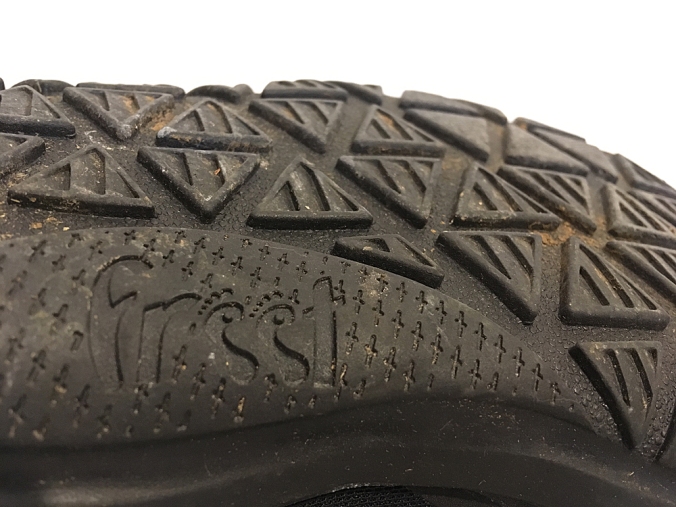
The outsole is a soft rubber compound which grips well to most surfaces that I’ve been on. The tread is moderately rugged, suitable for walking and running in soft mud, loose material and grass, as well as on hard surfaces. They are great for road running, trail running, gym, walking, or pubbing. I would be cautious about taking these running in wet muddy conditions, but otherwise they’re pretty much all-rounders.
The benefits of a soft and flexible sole are always balanced by the material’s resilience to wear on hard surfaces. These are at the softer end of the spectrum, and consequently the lugs are beginning to show signs of wear. That said, I have worn them almost every day since I received them in November.
The uppers are a thin, light and airy material, allowing your feet to keep cool. This does mean that they soak through quickly, but they don’t gain a lot of weight when wet, and they also dry very quickly.
They come with elastic ‘quick laces’ which can be pulled tight and secured with the spring fastener, and the flappy end has a neat little clip to stop it being flappy. Once fitted, there is enough give in them to just slip on and off without having to loosen and retighten.
Freet send a set of conventional laces in the box, if you prefer those, but you’ll have to cut the elastic laces to remove them, so there’s no going back once you’ve switched. If these are for use as everyday shoes, or for the gym or for road running, the elastic laces are ideal, but if they are to be used for off-road or trail running I would recommend switching to the conventional laces for fear of the elastic yielding too easily and allowing the shoes to be pulled off in mud or if snagged on something.
I love these. They are my new favourite shoes. They’re bare, light, comfy, wide, and they are just as well suited with a pair of jeans as with running kit. There’s nothing I don’t like. Well done Freet, this should be a top-selling shoe for everyone.

Share this:
Like this:
Freet Mudee – (Vegan & Waterproof) This lower cut hiking boot is light and flexible but not very breathable in warm weather. They fit close around the ankle for a secure fit, and are a favorite because they have a low price point. Made on the GripPlus outsole.
Freet Everyday Walking & Running Shoes
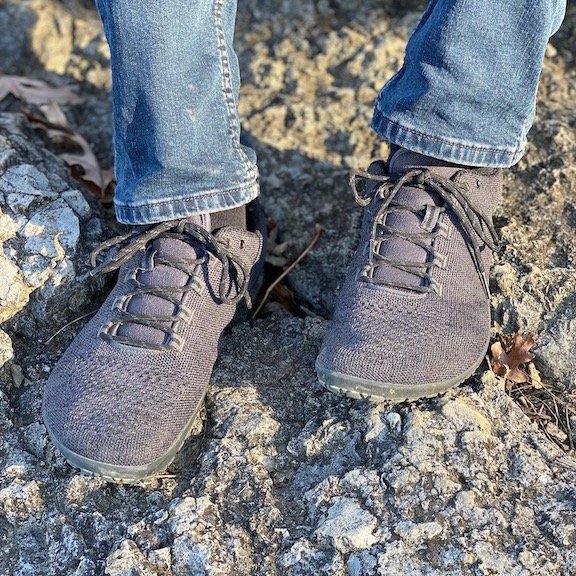
Freet Pace (vegan) – These sneakers come with the 6mm Ortholite insole, making them either 4 or 10mm thick (depending on if you use the insole or not). This makes them a great transitional shoe, or if you just need a little cushion. Justin has been wearing his almost daily for a year and a half – they’re like slippers! Made with the MultiGrip Outsole.
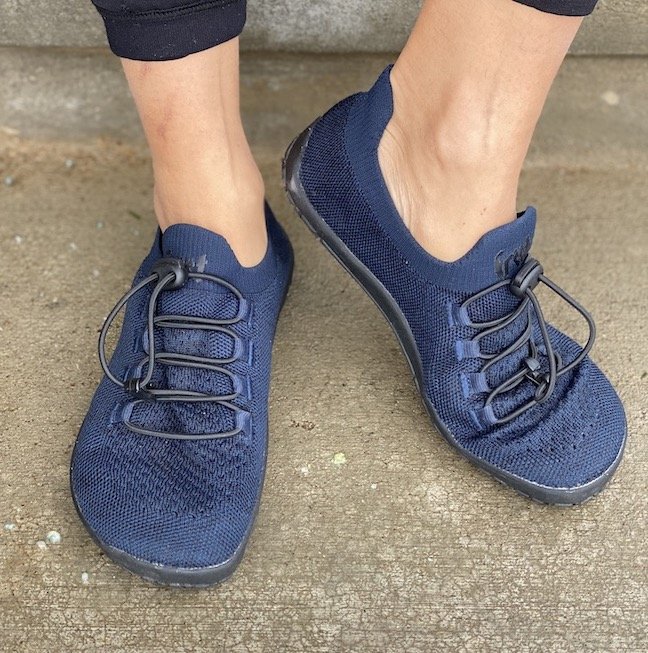
Freet Tanga (vegan) – This shoe has elastic laces and a sock-like upper. They can function as an athletic, water, or everyday shoe. I like how easy they are to put on, but be ware that they run small. I wish I had sized up one. Made with the MultiGrip Outsole.
In recent years their shoes have become very popular and I can definitely see why. They are perfect for outdoor activities, hikings and for all nature lovers. They are also very easy to maintain and not as expensive as some other barefoot shoes.
5. Price & where to buy
You can buy Freet shoes at their official website, but you can also find them at different retailers. A lot of them can be found on my list here. Use code KBN10 for 10% off on their official website.
My readers from US/Canada can also buy them at PedTerra (10% off on your first order at PedTerra with BOSENOGICE ), but not all Freet models are available there.